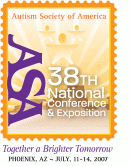 |
The ASA's 38th National Conference on Autism Spectrum Disorders (July 11-14, 2007) of ASAThe Westin Kierland Resort & Spa, Scottsdale, AZ |
| For a complete author index with session numbers, please click here | |
| Thursday, July 12, 2007: 10:45 AM-12:00 PM | |||
| Kirkland | |||
| #2528- Early Literacy, Communication and the Tango- ASHA CEU Session | |||
| This session will focus on practical strategies to scaffold early communication and language instruction with the new communication device called the Tango. A review of the organizational structure of the Tango’s language and unique communication modes will be emphasized. Discussion of how these features can play a key role in early language; communication, vocabulary and early conversation development for young children with autism will be highlighted. Case examples and hands on materials will be a pat of this session. | |||
| Presenter: | - • Pati King-DeBaun is a speech language pathologist who has specialized in communication for children who struggle to communicate. Pati is an adjunct professor at the University of Utah Special Education Department. She has written and continues to write and publish numerous articles, books and software (Storytime Series). Pati speaks and consults in a variety of classrooms internationally on the topics of interactive communication, augmentative communication, and early literacy for children with severe disabilities. | ||
|
| |||
|
There is considerable amount of debate on how to develop communication and/or intervention strategies for young communicators with complex communication needs. Do we provide conversational only based communication or do we provide students with a syntactic based system that involves composing language? This session will focus on the unique features of the Tango that provide a balance of communication modes. As discussed by Sutton, et .al ( 2002) the dominant mode of communication may reflect the physical, cognitive and linguistic capabilities of the student but should not limit the students' opportunities. The organization structure of the Tango allows the end user to eventually be able to determine what mode is appropriate for a given situation which will ultimately give the end user more communication control. Michael Williams (2000) discusses how his communication was limited by what his therapist put on his system. Those individuals who set up a child's communication system essentially hold the keys to the doors of communication. Sutton, et.al. (2002) state that, “Mismatches between modalities used for language input( speech) and language output ( graphic systems) may alter the acquisition process.” They suggest that there may be a difference in how children with complex communication needs learn language in comparison to speaking peers. Greenspan (2004), discusses how language development for speaking children including theories of MLU may not be accurate and that the complexity of environment and social emotional development play a key role in language development. The emotional component of language cannot be ignored, It is not surprising that early communication events must be based on the interests of the child or they have little meaning. In order to stimulate meaning, memory and vocabulary development the language learned should be based on the emotional reaction to an activity or event. We know that communication is a complex process that involves the integration of a variety of skills including, listening that may ultimately impact their communication. In this session participants will see case studies of nonverbal autistic children, in the severe range participating in conversations regarding emotion, events, and engagement. The affect and engagement of the children demonstrated with the use of Tango is impressive and also stimulates further conversation about instruction techniques. Wetherby and Prizant (2000) discuss how children with autism learn to communicate and that some children learn language in chunks or a gestalt type learning approach. They also suggest that a part of training emphasis is on functional use of language in natural settings. In this presentation, the language structure of the Tango will be introduced and demonstrated as a functional language based system. The 30 preprogrammed functional languae sets and words paired and content are based on school age routines at home and school, making it a very easy system to integrate into the natural environments almost immediately. This session will address several of the unique features of the Tango; ease of access, multi-modal conversations, early conversations and literacy, story retelling, core words and spelling pop ups, the intuitive design of word banks, and teaching strategies for in the classroom that focus on literacy. A discussion of the importance of conversations and discussions in the development of literacy and early writing will be emphasized and the need for balance in AAC systems. The concept of teaching children to use multiple modes of communication in conversation will be addressed and how the unique design of the Tango encourages this. A review of the organizational structure of the Tango's language and how it can play a key role in early literacy development for AAC users will be demonstrated. Specific strategies will address ease of access, multi-modal conversations, early conversations and literacy, story retelling, core words and spelling pop ups and their unique design, the intuitive design of word banks, teaching strategies for in the classroom that focus on literacy. This presentation is appropriate for preschool- school age. Case examples and hands on materials will be the highlight of this session. If we expect the student to become literate, a scaffolding process using multiple methods of conversational techniques should be modeled and taught to our students ( Smith, M, 2005,) By recognizing the need for development of grammatical structures and pragmatic use of language we can build the social/emotional relationships and the important language structures that are needed for academic and more importantly literacy success. There should be no compromises. |
|||
See more of General Submissions
See more of The ASA's 38th National Conference on Autism Spectrum Disorders (July 11-14, 2007)